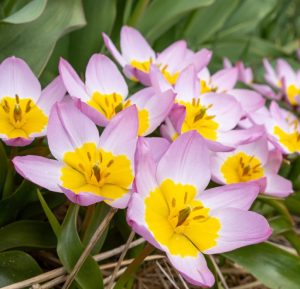Washington Tulip Festival Tulip History
 Tulips, with their captivating beauty and storied history, have left an indelible mark on cultures worldwide. These exquisite flowers have not only graced gardens and inspired art but have also played unique roles in survival, cultural symbolism, and even investment. From their ancestral origins in arid regions to the Turkish court's early fascination and their eventual journey to Holland's hybridizers and investors, tulips have a remarkable story to tell.
Tulips, with their captivating beauty and storied history, have left an indelible mark on cultures worldwide. These exquisite flowers have not only graced gardens and inspired art but have also played unique roles in survival, cultural symbolism, and even investment. From their ancestral origins in arid regions to the Turkish court's early fascination and their eventual journey to Holland's hybridizers and investors, tulips have a remarkable story to tell.
From Dry Hillsides to the Turkish Court Tulip Roots
The tale of the tulip begins in the rugged terrain of Central Asia, where approximately 150 species of "wild" tulips found their roots. These ancestral tulip species thrived in the harsh conditions of the Pamir Alai and Tien-Shan Mountain Ranges, near the modern-day Russian/Chinese border. Their presence extended eastward into China and westward as far as France and Spain, but the majority hailed from the arid expanses of Central Asia.
While many believe that tulips solely "come from Turkey," it is more accurate to acknowledge that the early botanists of the formidable Ottoman Empire, also known as the Turkish Empire, held a profound interest in tulips long before Europeans took notice. As early as 1,000 AD, the Turks were cultivating tulips within their expansive empire. It's worth noting that the territories where the tulips Europeans eventually imported thrived were once integral parts of the Ottoman Empire, encompassing regions around the Black Sea, the Crimea, and even the steppes north of the Caucasus.
The Tale of the Tulip: A Legend of Love
One of the most famous legends from Turkish folklore tells the story of a handsome prince named Farhad, who fell deeply in love with the enchanting maiden, Shirin. Tragically, he received news of her untimely demise, and in his inconsolable grief, he mounted his beloved horse and galloped over a precipice to his own demise. It is said that from every droplet of his spilled blood, a scarlet tulip sprang forth, forever immortalizing the flower as a symbol of perfect love.
of her untimely demise, and in his inconsolable grief, he mounted his beloved horse and galloped over a precipice to his own demise. It is said that from every droplet of his spilled blood, a scarlet tulip sprang forth, forever immortalizing the flower as a symbol of perfect love.
During the zenith of the Ottoman Empire's glory, the Sultans celebrated the tulip, and these flowers became intertwined with the trappings of wealth and power. One noteworthy anecdote recounts a Sultan who indulged excessively in a lavish tulip festival, ultimately leading to his downfall and the infamous loss of his head. Thus, long before the Dutch embarked on their own passionate affair with tulips, these blooms were already revered in their native lands. Today, the tulip proudly stands as the national flower of Turkey.
The Tulip's Journey Continues
As the tulip's journey unfolded, it found new homes and admirers across the globe. From dry hillsides to the Turkish court to Holland's hybridizers and investors, tulips have transcended time and place, symbolizing everything from love to opulence. Their remarkable history, from ancient legends to financial booms and busts, remains a testament to the enduring allure of nature's most vibrant blooms.
Washington Tulip Festival brings the legendary tulip to Skagit County every Spring in April.
Tulips, with their vibrant hues and intricate tales, have captured hearts and minds for centuries. Their journey from the arid landscapes of Central Asia to the opulent courts of the Ottoman Empire and, eventually, to the Dutch hybridizers and investors is a testament to their enduring appeal. These blossoms have symbolized love, wealth, and resilience, making them an integral part of our global cultural tapestry. Today, as tulips continue to bloom in gardens and floral arrangements, they remind us of their timeless beauty and the extraordinary stories that have made them legendary.
